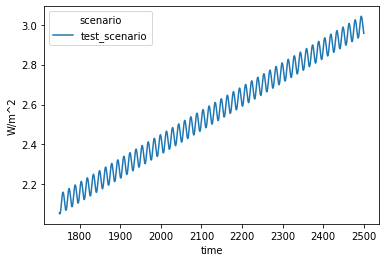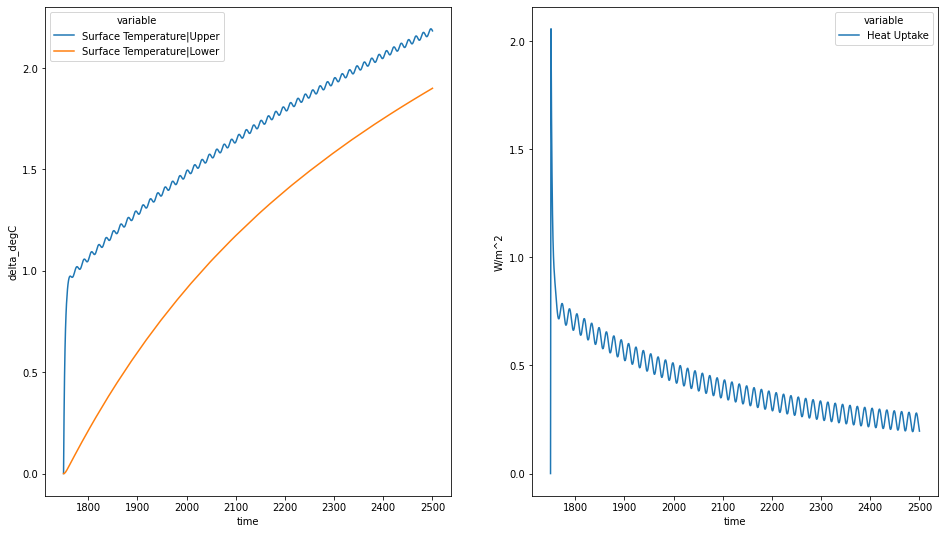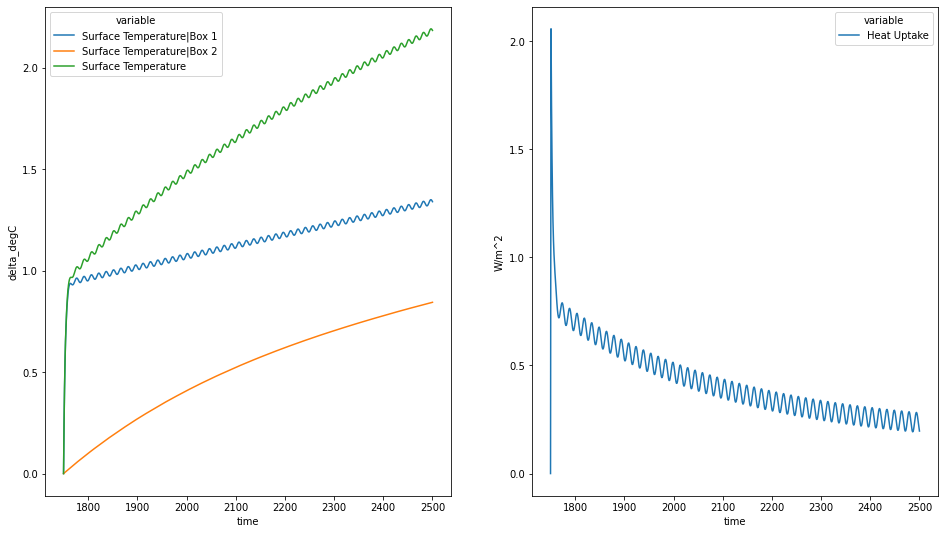Impulse response equivalence¶
In this notebook we explore the equivalence between the two-layer model and a two-timescale impulse response approach.
Background¶
Following Geoffroy et al., 2013, Part 2, with notation altered to match our implementation, the two-layer model with efficacy (\(\epsilon\)) and state-dependent climate feedback can be written as
If the state-dependent feedback factor, \(a\), is non-zero, the two-layer model and impulse response approaches are not equivalent. However, if \(a=0\), they become the same.
Hereafter we assume \(a=0\), however this assumption should not be forgotten. In the case \(a=0\), the two-layer model can be written (adding an \(\epsilon\) for the deep-ocean equation too for simplicity later).
In matrix notation we have
where \(\mathbf{X} = \begin{pmatrix}T \\T_D\end{pmatrix}\), \(\mathbf{A} = \begin{bmatrix} - \frac{\lambda_0 + \epsilon \eta}{C} & \frac{\epsilon \eta}{C} \\ \frac{\epsilon \eta}{\epsilon C_d} & -\frac{\epsilon \eta}{\epsilon C_d} \end{bmatrix}\) and \(\mathbf{B} = \begin{pmatrix} \frac{F}{C} \\ 0 \end{pmatrix}\).
As shown in Geoffroy et al., 2013, Part 1, \(\mathbf{A}\) can be diagonalised i.e. written in the form \(\mathbf{A} = \mathbf{\Phi} \mathbf{D} \mathbf{\Phi}^{-1}\), where \(\mathbf{D}\) is a diagonal matrix. Applying the solution given in Geoffroy et al., 2013, Part 1 to our impulse response notation, we have
and
where
Given this, we can re-write the system as
Defining \(\mathbf{Y} = \begin{pmatrix} T_1 \\ T_2 \end{pmatrix}\), we have
or,
Re-writing, we have,
We can compare this to the notation of Millar et al., 2017 and see that
Hence we have redemonstrated the equivalence of the two-layer model and a two-timescale impulse response model. Given the parameters of the two-layer model, we can now trivially derive the equivalent parameters of the two-timescale model. Doing the reverse is possible, but requires some more work in order to make a useable route drop out.
The first step is to follow Geoffroy et al., 2013, Part 1, and define two extra constants
These constants have the useful property that \(a_1 + a_2 = 1\) (proof in Appendix A).
From above, we also see that
Hence
Next we calculate \(C\) via
We then use further relationships from Table 1 of Geoffroy et al., 2013, Part 1 (proof is left to the reader) to calculate the rest of the constants.
Firstly,
and then finally,
The final thing to notice here is that \(C_D\), \(\epsilon\) and \(\eta\) are not uniquely-defined. This makes sense, as shown by Geoffroy et al., 2013, Part 2, the introduction of the efficacy factor does not alter the behaviour of the system (it is still the same mathematical system) and so it is impossible for simply the two-timescale temperature response to uniquely define all three of these quantities. It can only define the products \(\epsilon C_D\) and \(\epsilon \eta\). Hence when translating from the two-timescale model to the two-layer model with efficacy, an explicit choice for the efficacy must be made. This does not alter the temperature response but it does alter the implied ocean heat uptake of the two-timescale model.
Long story short, when deriving two-layer model parameters from a two-timescale model, one must specify the efficacy.
Given that \(\mathbf{Y} = \mathbf{\Phi}^{-1} \mathbf{X}\) i.e. \(\mathbf{X} = \mathbf{\Phi} \mathbf{Y}\), we can also relate the impulse response boxes to the two layers.
Finally, the equivalent of the two-timescale and two-layer models allows us to also calculate the heat uptake of a two-timescale impulse response model. It is given by
Running the code¶
Here we actually run the two implementations to explore their similarity.
[1]:
import datetime as dt
import numpy as np
import pandas as pd
from openscm_units import unit_registry as ur
from scmdata.run import ScmRun, run_append
from openscm_twolayermodel import ImpulseResponseModel, TwoLayerModel
import matplotlib.pyplot as plt
/home/docs/checkouts/readthedocs.org/user_builds/openscm-two-layer-model/envs/stable/lib/python3.7/site-packages/openscm_twolayermodel/base.py:10: TqdmExperimentalWarning: Using `tqdm.autonotebook.tqdm` in notebook mode. Use `tqdm.tqdm` instead to force console mode (e.g. in jupyter console)
import tqdm.autonotebook as tqdman
First we define a scenario to run.
[2]:
time = np.arange(1750, 2501)
forcing = 0.05 * np.sin(time / 15 * 2 * np.pi) + 3.0 * time / time.max()
inp = ScmRun(
data=forcing,
index=time,
columns={
"scenario": "test_scenario",
"model": "unspecified",
"climate_model": "junk input",
"variable": "Effective Radiative Forcing",
"unit": "W/m^2",
"region": "World",
},
)
inp
[2]:
<scmdata.ScmRun (timeseries: 1, timepoints: 751)>
Time:
Start: 1750-01-01T00:00:00
End: 2500-01-01T00:00:00
Meta:
climate_model model region scenario unit \
0 junk input unspecified World test_scenario W/m^2
variable
0 Effective Radiative Forcing
[3]:
# NBVAL_IGNORE_OUTPUT
inp.lineplot()
[3]:
<AxesSubplot:xlabel='time', ylabel='W/m^2'>

Next we run the two-layer model. In order for it to be convertible to a two-timescale model, we must turn state-dependence off (a=0).
[4]:
two_layer_config = {
"du": 55 * ur("m"),
"efficacy": 1.2 * ur("dimensionless"),
# "efficacy": 1.0 * ur("dimensionless"),
"a": 0 * ur("W/m^2/delta_degC^2"),
}
[5]:
# NBVAL_IGNORE_OUTPUT
twolayer = TwoLayerModel(**two_layer_config)
res_twolayer = twolayer.run_scenarios(inp)
res_twolayer
[5]:
<scmdata.ScmRun (timeseries: 4, timepoints: 751)>
Time:
Start: 1750-01-01T00:00:00
End: 2500-01-01T00:00:00
Meta:
a (watt / delta_degree_Celsius ** 2 / meter ** 2) climate_model \
0 0.0 two_layer
1 0.0 two_layer
2 0.0 two_layer
3 0.0 two_layer
dl (meter) du (meter) efficacy (dimensionless) \
0 1200 55 1.2
1 1200 55 1.2
2 1200 55 1.2
3 1200 55 1.2
eta (watt / delta_degree_Celsius / meter ** 2) \
0 0.8
1 0.8
2 0.8
3 0.8
lambda0 (watt / delta_degree_Celsius / meter ** 2) model region \
0 1.246667 unspecified World
1 1.246667 unspecified World
2 1.246667 unspecified World
3 1.246667 unspecified World
run_idx scenario unit variable
0 0 test_scenario W/m^2 Effective Radiative Forcing
1 0 test_scenario delta_degC Surface Temperature|Upper
2 0 test_scenario delta_degC Surface Temperature|Lower
3 0 test_scenario W/m^2 Heat Uptake
[6]:
# NBVAL_IGNORE_OUTPUT
fig = plt.figure(figsize=(16, 9))
ax = fig.add_subplot(121)
res_twolayer.filter(variable="*Temperature*").lineplot(hue="variable", ax=ax)
ax = fig.add_subplot(122)
res_twolayer.filter(variable="Heat Uptake").lineplot(hue="variable", ax=ax)
[6]:
<AxesSubplot:xlabel='time', ylabel='W/m^2'>

Next we get the parameters with which we get the equivalent impulse response model.
[7]:
two_timescale_paras = twolayer.get_impulse_response_parameters()
two_timescale_paras
[7]:
{'d1': 103454323.57029569 <Unit('joule / watt')>,
'd2': 11181891933.114195 <Unit('joule / watt')>,
'q1': 0.4465999986742509 <Unit('delta_degree_Celsius * meter ** 2 / watt')>,
'q2': 0.3555390387589074 <Unit('delta_degree_Celsius * meter ** 2 / watt')>,
'efficacy': 1.2 <Unit('dimensionless')>}
[8]:
# NBVAL_IGNORE_OUTPUT
impulse_response = ImpulseResponseModel(**two_timescale_paras)
res_impulse_response = impulse_response.run_scenarios(inp)
res_impulse_response
[8]:
<scmdata.ScmRun (timeseries: 5, timepoints: 751)>
Time:
Start: 1750-01-01T00:00:00
End: 2500-01-01T00:00:00
Meta:
climate_model d1 (joule / watt) d2 (joule / watt) \
0 two_timescale_impulse_response 1.034543e+08 1.118189e+10
1 two_timescale_impulse_response 1.034543e+08 1.118189e+10
2 two_timescale_impulse_response 1.034543e+08 1.118189e+10
3 two_timescale_impulse_response 1.034543e+08 1.118189e+10
4 two_timescale_impulse_response 1.034543e+08 1.118189e+10
efficacy (dimensionless) model \
0 1.2 unspecified
1 1.2 unspecified
2 1.2 unspecified
3 1.2 unspecified
4 1.2 unspecified
q1 (delta_degree_Celsius * meter ** 2 / watt) \
0 0.4466
1 0.4466
2 0.4466
3 0.4466
4 0.4466
q2 (delta_degree_Celsius * meter ** 2 / watt) region run_idx \
0 0.355539 World 0
1 0.355539 World 0
2 0.355539 World 0
3 0.355539 World 0
4 0.355539 World 0
scenario unit variable
0 test_scenario W/m^2 Effective Radiative Forcing
1 test_scenario delta_degC Surface Temperature|Box 1
2 test_scenario delta_degC Surface Temperature|Box 2
3 test_scenario delta_degC Surface Temperature
4 test_scenario W/m^2 Heat Uptake
[9]:
# NBVAL_IGNORE_OUTPUT
fig = plt.figure(figsize=(16, 9))
ax = fig.add_subplot(121)
res_impulse_response.filter(variable="*Temperature*").lineplot(
hue="variable", ax=ax
)
ax = fig.add_subplot(122)
res_impulse_response.filter(variable="Heat Uptake").lineplot(
hue="variable", ax=ax
)
[9]:
<AxesSubplot:xlabel='time', ylabel='W/m^2'>

We can compare the two responses as well.
[10]:
# NBVAL_IGNORE_OUTPUT
combined = run_append([res_impulse_response, res_twolayer])
combined
[10]:
<scmdata.ScmRun (timeseries: 9, timepoints: 751)>
Time:
Start: 1750-01-01T00:00:00
End: 2500-01-01T00:00:00
Meta:
a (watt / delta_degree_Celsius ** 2 / meter ** 2) \
0 NaN
1 NaN
2 NaN
3 NaN
4 NaN
5 0.0
6 0.0
7 0.0
8 0.0
climate_model d1 (joule / watt) d2 (joule / watt) \
0 two_timescale_impulse_response 1.034543e+08 1.118189e+10
1 two_timescale_impulse_response 1.034543e+08 1.118189e+10
2 two_timescale_impulse_response 1.034543e+08 1.118189e+10
3 two_timescale_impulse_response 1.034543e+08 1.118189e+10
4 two_timescale_impulse_response 1.034543e+08 1.118189e+10
5 two_layer NaN NaN
6 two_layer NaN NaN
7 two_layer NaN NaN
8 two_layer NaN NaN
dl (meter) du (meter) efficacy (dimensionless) \
0 NaN NaN 1.2
1 NaN NaN 1.2
2 NaN NaN 1.2
3 NaN NaN 1.2
4 NaN NaN 1.2
5 1200.0 55.0 1.2
6 1200.0 55.0 1.2
7 1200.0 55.0 1.2
8 1200.0 55.0 1.2
eta (watt / delta_degree_Celsius / meter ** 2) \
0 NaN
1 NaN
2 NaN
3 NaN
4 NaN
5 0.8
6 0.8
7 0.8
8 0.8
lambda0 (watt / delta_degree_Celsius / meter ** 2) model \
0 NaN unspecified
1 NaN unspecified
2 NaN unspecified
3 NaN unspecified
4 NaN unspecified
5 1.246667 unspecified
6 1.246667 unspecified
7 1.246667 unspecified
8 1.246667 unspecified
q1 (delta_degree_Celsius * meter ** 2 / watt) \
0 0.4466
1 0.4466
2 0.4466
3 0.4466
4 0.4466
5 NaN
6 NaN
7 NaN
8 NaN
q2 (delta_degree_Celsius * meter ** 2 / watt) region run_idx \
0 0.355539 World 0
1 0.355539 World 0
2 0.355539 World 0
3 0.355539 World 0
4 0.355539 World 0
5 NaN World 0
6 NaN World 0
7 NaN World 0
8 NaN World 0
scenario unit variable
0 test_scenario W/m^2 Effective Radiative Forcing
1 test_scenario delta_degC Surface Temperature|Box 1
2 test_scenario delta_degC Surface Temperature|Box 2
3 test_scenario delta_degC Surface Temperature
4 test_scenario W/m^2 Heat Uptake
5 test_scenario W/m^2 Effective Radiative Forcing
6 test_scenario delta_degC Surface Temperature|Upper
7 test_scenario delta_degC Surface Temperature|Lower
8 test_scenario W/m^2 Heat Uptake
To within numerical errors they are equal.
[11]:
# NBVAL_IGNORE_OUTPUT
fig = plt.figure(figsize=(16, 9))
ax = fig.add_subplot(121)
combined.filter(variable="*Temperature*").lineplot(
hue="variable", style="climate_model", alpha=0.7, linewidth=2, ax=ax
)
ax.legend(loc="upper left")
ax = fig.add_subplot(122)
combined.filter(variable="Heat Uptake").lineplot(
hue="climate_model", style="climate_model", alpha=0.7, linewidth=2, ax=ax
)
[11]:
<AxesSubplot:xlabel='time', ylabel='W/m^2'>

Appendix A¶
We begin with the definitions of the \(a\) constants,
We then have
Recalling the definition of the \(\phi\) parameters,
We have,
Recalling the definition of the \(\tau\) parameters,
We have,
Recalling the definition of the \(b\) parameters,
We then have
Putting it all back together,